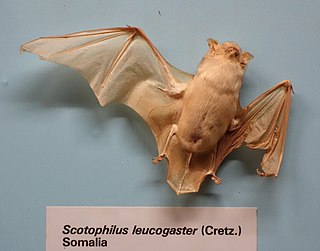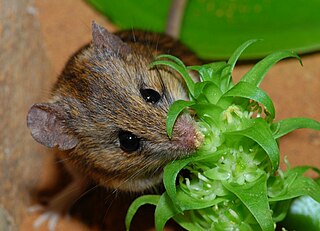
Southern Africa is the southernmost region of Africa. There is no one agreed-upon definition, but some groupings include the United Nations geoscheme, the inter-governmental Southern African Development Community, and the physical geography definition based on the physical characteristics of the land.

Gerbillinae is one of the subfamilies of the rodent family Muridae and includes the gerbils, jirds, and sand rats. Once known as desert rats, the subfamily includes about 110 species of African, Indian, and Asian rodents, including sand rats and jirds, all of which are adapted to arid habitats. Most are primarily active during the day, making them diurnal, and almost all are omnivorous.

The white-bellied yellow bat or white-bellied house bat, is a species of vesper bat in the genus Scotophilus, the house bats. It can be found in Angola, Benin, Botswana, Burkina Faso, Cameroon, Central African Republic, Chad, Ivory Coast, Gambia, Ghana, Guinea, Guinea-Bissau, Kenya, Mali, Mauritania, Namibia, Niger, Nigeria, Senegal, Sierra Leone, Sudan, Togo, Uganda, and Zambia. It is found in dry and moist savanna and open woodland. It is a common species with a very wide range, and the International Union for Conservation of Nature has assessed its conservation status as being of "least concern".
The Zulu serotine, also called the Zulu pipistrelle, aloe bat, or aloe serotine, is a species of vesper bat found in Angola, Botswana, Democratic Republic of the Congo, Ethiopia, Kenya, Malawi, Namibia, South Africa, South Sudan, Uganda, Zambia, and Zimbabwe. Its natural habitats are savanna and hot deserts.

The Namaqua rock rat is a species of rodent in the family Muridae. It is sometimes included in the genus Micaelamys. It is found in Angola, Botswana, Lesotho, Malawi, Mozambique, Namibia, South Africa, Eswatini, Zambia, and Zimbabwe. Its natural habitats are temperate forest, dry savanna, temperate shrubland, subtropical or tropical dry shrubland, temperate grassland, rocky areas, hot desert, temperate desert, rocky shores, arable land, rural gardens, and urban areas.

The hairy-footed gerbil is a species of rodent found in Angola, Botswana, Mozambique, Namibia, South Africa, and Zimbabwe. Its natural habitats are dry savanna, temperate shrubland, hot deserts, sandy shores, and urban areas. All members of this genus have hair on the soles of their feet, hence the name. They prefer sandy soil or sandy alluvium with grass, scrub or light woodland cover.
The Namib brush-tailed gerbil or Setzer's hairy-footed gerbil is a species of rodent endemic to Angola and Namibia. Its natural habitats are sandy and gravelly plains. It stays in its burrow by day, emerging at night to feed on arthropods, vegetable matter, and seeds.
Littledale's whistling rat is one of two species of murid rodent in the genus Parotomys, the other being Brants's whistling rat. It is found in Namibia and South Africa. Its natural habitats are temperate shrubland, subtropical or tropical dry shrubland, and temperate desert.
Boehm's gerbil is a species of rodent found in Angola, Burundi, Democratic Republic of the Congo, Kenya, Malawi, Mozambique, Rwanda, Tanzania, Uganda, and Zambia. Its natural habitats are dry savanna, moist savanna, and arable land. This is a common species with a wide distribution which faces no obvious threats, so in 2004 the International Union for Conservation of Nature rated its conservation status as being of "least concern".
The Guinean gerbil is a species of rodent found in Burkina Faso, Gambia, Ghana, Guinea, Guinea-Bissau, Ivory Coast, Mali, Senegal, Sierra Leone, and possibly Liberia. Its natural habitats are subtropical or tropical dry forests, dry savanna, rocky areas and arable land, but it is mostly found in areas laterite or clay soils, and with variable amounts of vegetation and dense scrub. This species is described as common and has a stable population and a wide distribution, so the International Union for Conservation of Nature has rated its conservation status as being of "least concern".

The bushveld gerbil is a species of rodent found in Angola, Botswana, Democratic Republic of the Congo, Kenya, Malawi, Mozambique, Namibia, South Africa, Eswatini, Tanzania, Uganda, Zambia, and Zimbabwe. Its natural habitats are dry savanna, subtropical or tropical dry shrubland, subtropical or tropical dry lowland grassland, and hot deserts. Older sources classify it in the genus Tatera.

The African common toad or guttural toad is a species of toad in the family Bufonidae. It is found in Angola, Botswana, Democratic Republic of the Congo, Kenya, Lesotho, Malawi, Mauritius, Mozambique, Namibia, Réunion, Somalia, South Africa, Ethiopia, Eswatini, Tanzania, Zambia, and Zimbabwe. Its natural habitats are subtropical or tropical dry forest, subtropical or tropical moist lowland forest, subtropical or tropical moist montane forest, dry savanna, moist savanna, temperate shrubland, subtropical or tropical dry shrubland, subtropical or tropical moist shrubland, subtropical or tropical dry lowland grassland, subtropical or tropical seasonally wet or flooded lowland grassland, subtropical or tropical high-altitude grassland, intermittent rivers, freshwater lakes, intermittent freshwater lakes, freshwater marshes, intermittent freshwater marshes, arable land, pastureland, rural gardens, urban areas, heavily degraded former forest, ponds, and canals and ditches.

The Mohol bushbaby is a species of primate in the family Galagidae which is native to mesic woodlands of the southern Afrotropics. It is physically very similar to the Senegal bushbaby, and was formerly considered to be its southern race. The two species differ markedly in their biology however, and no hybrids have been recorded in captivity.

The swamp musk shrew, or musk shrew, is a species of mammal in the family Soricidae. It occurs in Angola, Botswana, Democratic Republic of the Congo, Mozambique, Namibia, South Africa, Eswatini, Zambia and Zimbabwe. Its natural habitat is swamps, and it is a common species in suitable habitats, with the International Union for Conservation of Nature listing it as being of "least concern".

The Peters's epauletted fruit bat is a species of megabat in the family Pteropodidae. It is found in Angola, Botswana, Democratic Republic of the Congo, Eswatini, Malawi, Mozambique, Namibia, Tanzania, Zambia, and Zimbabwe. Its natural habitat is in riverine or evergreen forest, or moist woodland, where there are fruit-bearing trees.

Darling's horseshoe bat is a species of bat in the family Rhinolophidae found in Africa. Its natural habitats are dry savanna, caves and other subterranean habitats.

Telescopus semiannulatus, commonly known as the common tiger snake, tiger cat snake, or eastern tiger snake is a species of rear-fanged colubrid snake. It is widespread in central, eastern, and southern Africa.

Gerbilliscus is a genus of rodent in the subfamily Gerbillinae (gerbils) of the family Muridae. It contains the following species, all native to Africa:
The Zambezian region is a large biogeographical region in Africa. The Zambezian region includes woodlands, savannas, grasslands, and thickets, extending from east to west in a broad belt across the continent. The Zambezian region lies south of the rainforests of the Guineo-Congolian region. The Zambezian region is bounded by deserts and xeric shrublands on the southwest, the Highveld grasslands of South Africa to the south, and the subtropical Maputaland forests on the southeast.














